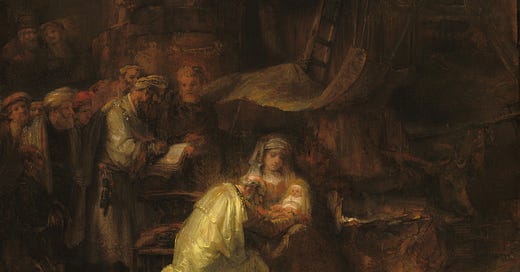
I could not name my “favorite painter” any more than I could name my “favorite composer.” However, everyone does have favorites, and Rembrandt tops the list for me. Every time I visit a major museum, I head straight for his work, to make sure I spend a luxurious amount of time on it, before touring the rest (as much as time allows).
When I look back, I can see the beginnings of this fascination in high school, when my first art history class with Fr. Beatus Lucey (1933-2022) opened my eyes to the greatness of great art. How could I forget the way he regally ascended the steps of Old Main at Delbarton School, bellowing out “Blest be the art that can immortalize” to let us all know he was coming?
Although born in Chicago—Arlington Heights, to be precise—my parents moved to northern New Jersey when I was but a year and a half old, and that’s where I lived, in a smallish town called Madison, until I left for college in the fall of 1989. Many times growing up, we’d make the one-hour trip into “the City,” where I sometimes visited my father in the years he worked on a floor near the top of the World Trade Center (that was long before 9/11). One July 4th I got to see the fireworks in the harbor from up there.
In high school, my favorite trips into the City tended to gravitate around one of two museums: the Frick on 70th and the Met on 5th Ave, in easy walking distance of each other. At the Met, I remember gazing enraptured on Aristotle Contemplating the Bust of Homer. Later, my future wife accompanied me there too. It was almost a destination holiday to visit the Rembrandt rooms.
Thus, it was entirely unsurprising that when I visited the National Gallery of Art in DC not too long ago, for the first time in decades, it was to Rembrandt that I hastened. With no remembrance of what I had seen there as a young man, I looked forward to whatever delights the collection could offer.
Although every one of the master’s paintings was worth a good long look, I found myself especially entranced by one I don’t recall ever having seen before: The Circumcision. As the National Gallery commentary notes, it is an innovative composition: breaking with convention, Rembrandt portrays the event as occurring not in the Temple but in the humble stable where Jesus was born, and, instead of Joseph or another male figure, has Mary holding Him for the ceremony.
Keep reading with a 7-day free trial
Subscribe to Tradition and Sanity to keep reading this post and get 7 days of free access to the full post archives.




